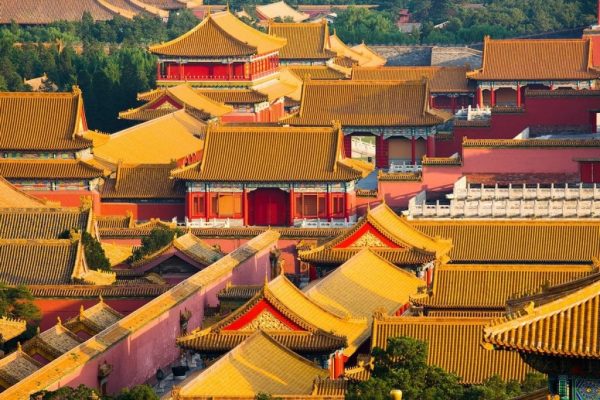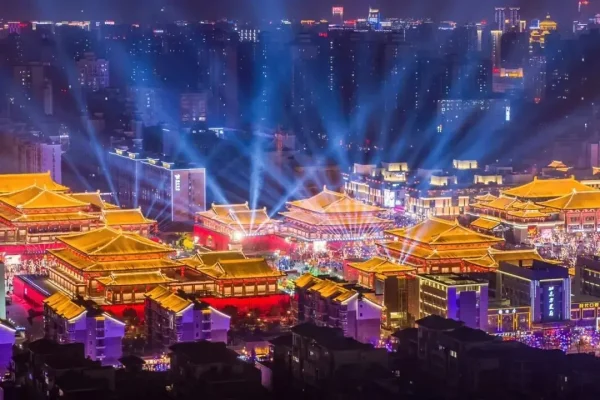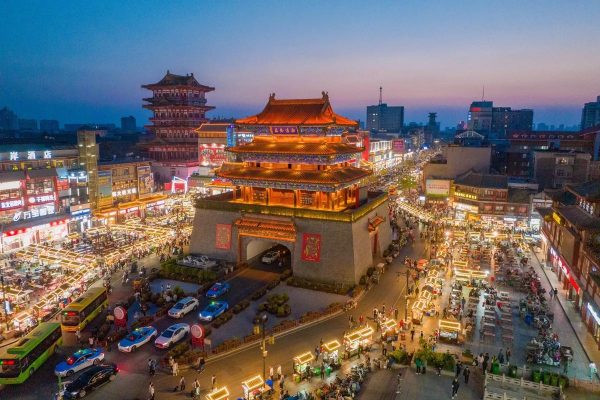Nanjing, nestled along the banks of the Yangtze River, is a city where history breathes in every brick and bustling modernity dances with age-old traditions. Known as Jinling in ancient times, it served as the capital for six dynasties, leaving behind a rich legacy of imperial palaces, sacred temples, and poignant historical sites. Today, this vibrant metropolis in Jiangsu Province seamlessly blends its storied past with contemporary energy, offering travelers a captivating mix of cultural immersion, natural beauty, and culinary delights. This comprehensive guide will help you explore Nanjing’s top attractions, savor its unique cuisine, find the perfect accommodation, and navigate the city with ease.
Must-See Historical and Cultural Attractions
Sun Yat-sen Mausoleum
Perched on the southern slope of Purple Mountain, the Sun Yat-sen Mausoleum is one of China’s most important historical landmarks, dedicated to Dr. Sun Yat-sen, the father of modern China and founder of the Republic of China. The grand mausoleum, designed in a fusion of traditional Chinese and Western architectural styles, features a 392-step staircase leading to the main hall, where a seated statue of Dr. Sun Yat-sen resides.
Surrounded by lush pine forests, the mausoleum offers serene views of Nanjing. It is advisable to visit early in the morning to avoid crowds and the midday heat. Combine your visit with a trip to the nearby Dr. Sun Yat-sen’s Memorial Hall, which houses exhibits on his life and revolutionary activities. The site is free to enter but requires a reservation during peak seasons.
Confucius Temple and Qinhuai River
The Confucius Temple (Fuzimiao) area is a lively hub of traditional culture, centered around the 11th-century temple dedicated to Confucius. The temple complex includes the Dacheng Hall, where a statue of Confucius stands, and beautiful gardens adorned with ancient inscriptions.
Adjacent to the temple is the Qinhuai River, once the cultural heart of Nanjing and immortalized in classical poetry. Take a nighttime boat cruise along the river to admire the illuminated pavilions, ancient bridges, and traditional architecture lining the shores. The surrounding streets are filled with shops selling handicrafts, calligraphy, and local snacks, making it a perfect place to soak up Nanjing’s 市井 (shìjǐng, 市井) culture. Don’t miss the colorful lantern displays during festivals, especially the Lantern Festival in February.
Ming Xiaoling Mausoleum
A UNESCO World Heritage Site, the Ming Xiaoling Mausoleum is the final resting place of Zhu Yuanzhang, the first emperor of the Ming Dynasty, and his empress. Located at the foot of Purple Mountain, it is one of the largest imperial mausoleums in China, spanning over 170,000 square meters.
The mausoleum’s approach is marked by a 1.8-kilometer-long sacred way lined with 12 pairs of stone statues, including elephants, lions, and horses, each carved with intricate detail. The main complex features grand gates, halls, and a tomb mound surrounded by walls. The peaceful atmosphere and well-preserved architecture make it a must-visit for history enthusiasts. Allow 2-3 hours to explore, and consider renting a bike to move between the various sections.
Nanjing Massacre Memorial Hall
A profoundly moving site, the Nanjing Massacre Memorial Hall commemorates the victims of the 1937 Nanjing Massacre during World War II. The memorial, designed to evoke reflection and remembrance, includes exhibition halls with historical photographs, artifacts, and survivor testimonies, as well as outdoor memorials such as the “Pit of 10,000 Corpses” and the “Wall of Names” inscribed with the names of over 3,000 victims.
Visiting the memorial is a somber experience, but it is an important reminder of history. Visitors are asked to maintain silence and dress respectfully. The memorial is free to enter, but photography is prohibited in certain areas. It is located in the western part of the city, and combining it with a visit to the nearby Nanjing Museum (one of China’s top museums) can provide a broader context of the city’s history.
Purple Mountain Observatory
For a mix of history and astronomy, head to the Purple Mountain Observatory, founded in 1934 and one of China’s oldest modern observatories. Perched atop Purple Mountain, it offers panoramic views of Nanjing and houses a collection of ancient astronomical instruments, including bronze armillary spheres and sundials from the Ming and Qing dynasties.
The observatory’s modern telescopes are also open to visitors, allowing you to stargaze (weather permitting). It is a great spot to visit in the afternoon, as the sunset views over the city are spectacular. The journey to the top involves a short hike or a bus ride from the base of the mountain.
Culinary Delights
Nanjing’s cuisine, known as Jinling cuisine, is characterized by its delicate flavors, emphasis on fresh ingredients, and a mix of savory and sweet dishes. Here are some must-try specialties:
- Salted Duck (Yanshui Ya): Nanjing’s most famous dish, salted duck is tender, flavorful, and slightly salty, with crispy skin. It is often served cold as an appetizer. The best places to try it are Jinling Restaurant and local markets.
- Duck Blood Vermicelli Soup (Yaxue Fen): A comforting soup made with duck blood, vermicelli noodles, duck intestines, and other offal, simmered in a rich duck broth. It is a popular street food, available at stalls near Confucius Temple.
- Small Steamed Buns (Xiaolongbao): Nanjing’s version of xiaolongbao features a thin dough wrapper filled with pork or crab meat and a savory broth. They are steamed to perfection and served with vinegar. Try them at Gaochun Xiaolongbao near Fuzimiao.
- Sesame Cake (Zhima Bing): A crispy, flaky cake filled with sweet sesame paste, often enjoyed as a breakfast snack or dessert. It can be found at traditional bakeries throughout the city.
- Beggar’s Chicken (Jiǎohuā Jī): A legendary dish where a whole chicken is stuffed with herbs and spices, wrapped in lotus leaves and clay, and baked until tender. The clay seals in the flavors, resulting in juicy, aromatic meat. It is a specialty of Nanjing and is served at high-end restaurants like Lao Zhengxing.
Accommodation Options
Nanjing offers a wide range of accommodation choices to suit different budgets and preferences:
- Luxury: The Ritz-Carlton Nanjing is located in the heart of the city, offering luxurious rooms with views of the Qinhuai River and top-notch amenities, including a spa and fine dining restaurants. The Four Seasons Hotel Nanjing is another excellent choice, situated in the business district with elegant decor and impeccable service.
- Mid-Range: Hanjiang Hotel near Confucius Temple combines traditional Chinese design with modern comfort, offering spacious rooms at affordable prices. Hampton by Hilton Nanjing Gulou is conveniently located near major attractions and transportation hubs, with a focus on comfort and convenience.
- Budget: Nanjing Youth Hostel near Xinjiekou is popular with backpackers, offering dormitory beds and private rooms, as well as a communal kitchen and lounge. 7 Days Inn has multiple branches throughout the city, providing clean, basic rooms at budget-friendly rates.
Transportation
- Getting Around: Nanjing has an efficient subway system with 11 lines, covering all major attractions and districts. It is the most convenient and affordable way to travel, with fares ranging from ¥2 to ¥10. Buses are also widely available, but can be crowded during peak hours. Taxis are plentiful and reasonably priced, with a starting fare of ¥11 for the first 3 kilometers.
- From the Airport: Nanjing Lukou International Airport is located about 35 kilometers south of the city center. The Airport Express Line 1 of the subway connects the airport to downtown Nanjing in approximately 40 minutes. Airport buses and taxis are also available, with taxis taking around 45 minutes and costing ¥100-150.
- Intercity Travel: Nanjing is well-connected to other major cities in China via high-speed rail. Nanjing South Railway Station is one of Asia’s largest railway stations, with frequent services to Shanghai (1 hour), Beijing (4 hours), and Hangzhou (1.5 hours).
Travel Tips
- Best Time to Visit: The ideal time to visit Nanjing is in spring (March-May) when the cherry blossoms and plum blossoms are in full bloom, especially in Jiming Temple and Mochou Lake Park. Autumn (September-November) is also pleasant, with mild temperatures and clear skies. Summer can be hot and humid, while winter is cold but less crowded.
- Language: English is spoken in major hotels, tourist attractions, and restaurants, but it is still helpful to have a translation app like WeChat Translate or Google Translate for communication with locals.
- Cash and Cards: Credit cards are widely accepted in hotels, restaurants, and large stores, but it is advisable to carry cash for small purchases, street food, and markets. ATMs are readily available throughout the city.
- Cultural Etiquette: When visiting temples and memorials, dress modestly and speak quietly. Remove your hat when entering indoor spaces of religious sites. It is polite to ask for permission before taking photos of people, especially elderly locals.
- Safety: Nanjing is generally a safe city, but like any major metropolis, it is important to keep an eye on your belongings in crowded areas such as subway stations and tourist attractions.
Nanjing is a city that captivates with its historical depth, natural beauty, and warm hospitality. From the grandeur of imperial mausoleums to the charm of the Qinhuai River, from the somber remembrance of the past to the vibrancy of modern life, Nanjing offers a journey that is both educational and enchanting. Whether you are a history buff, a food lover, or simply a traveler seeking new experiences, Nanjing is sure to leave a lasting impression.





